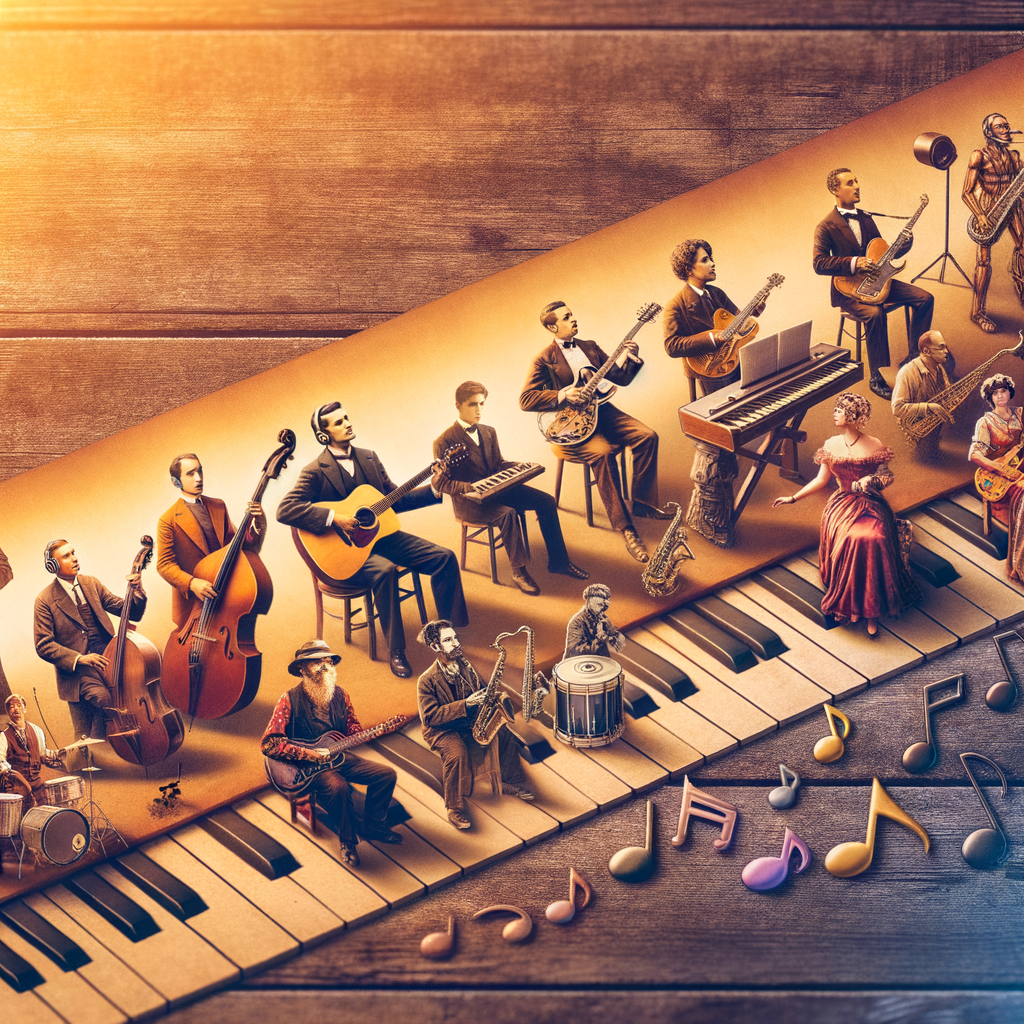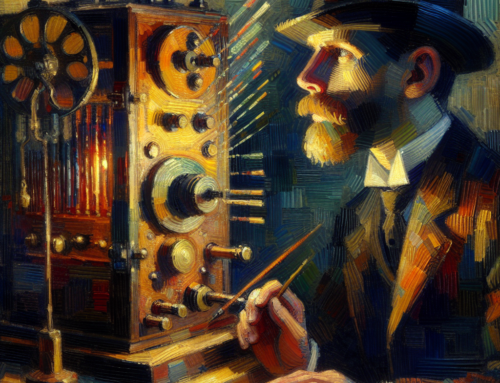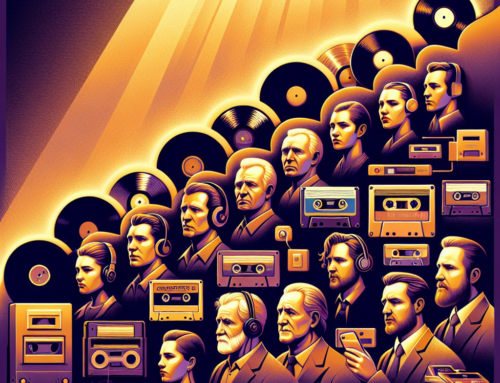-
Table of Contents
“From MP3s to Modern Melodies: Tracing the Evolution of Online Music Streaming”
Introduction
The evolution of online music streaming is a fascinating journey that traces back to the early days of digital audio technology. It began with the advent of the MP3 format in the late 1980s and early 1990s, which revolutionized the way music was stored and shared. This compression technology made it possible to reduce the size of audio files without significantly compromising quality, enabling easier distribution over the internet. The rise of peer-to-peer file-sharing networks like Napster in the late 1990s further accelerated the shift towards digital music consumption, despite legal challenges from the music industry. As technology advanced, legitimate streaming services emerged, offering vast libraries of music accessible on-demand. Platforms like Spotify, Apple Music, and others have since transformed the music industry, providing users with unprecedented access to music while reshaping how artists distribute and monetize their work. This transition from MP3s to modern streaming platforms marks a significant milestone in the digital age, reflecting broader changes in consumer behavior and technological innovation.
Evolution Of MP3 Technology And Its Impact On Music Consumption

The journey of online music streaming is a fascinating tale that begins with the humble MP3, a format that revolutionized how we consume music today. Back in the late 1990s, the MP3 format emerged as a game-changer, allowing music to be compressed into smaller files without a significant loss in quality. This was a big deal because, before MP3s, music files were bulky and cumbersome, making them difficult to share or store on personal devices. The advent of MP3 technology meant that music lovers could now carry entire albums in their pockets, a concept that was almost unimaginable at the time.
As MP3s gained popularity, they paved the way for peer-to-peer file-sharing platforms like Napster. Napster, launched in 1999, was a pioneer in the online music sharing space, allowing users to share and download music files for free. This was both exciting and controversial, as it challenged the traditional music industry model and sparked debates about copyright and artist compensation. Despite its legal troubles and eventual shutdown, Napster’s influence was undeniable. It set the stage for a new era of music consumption, where access to a vast library of songs was just a click away.
Transitioning from the chaos of file-sharing networks, the early 2000s saw the rise of legal digital music stores, with Apple’s iTunes leading the charge. iTunes offered a legitimate way to purchase and download music, providing a much-needed solution to the piracy problem. This shift not only benefited artists and record labels but also gave consumers a reliable and user-friendly platform to explore and buy music. The success of iTunes demonstrated that people were willing to pay for digital music if it was convenient and affordable.
However, as technology continued to evolve, so did consumer expectations. People wanted more than just ownership of individual tracks; they craved instant access to a vast array of music without the hassle of downloading. This desire for convenience and variety led to the birth of modern music streaming platforms like Spotify, Pandora, and Apple Music. These services offered users the ability to stream millions of songs on-demand, creating personalized playlists and discovering new music through curated recommendations.
The impact of these streaming platforms on music consumption has been profound. They have democratized access to music, allowing independent artists to reach global audiences without the backing of major record labels. Moreover, streaming has changed the way we interact with music, shifting the focus from owning to experiencing. Listeners can now explore diverse genres and artists with ease, broadening their musical horizons in ways that were previously unimaginable.
In conclusion, the evolution of MP3 technology and the subsequent rise of online music streaming have transformed the music industry and our listening habits. From the early days of Napster to the sophisticated streaming services we enjoy today, each step in this journey has brought us closer to a world where music is more accessible and enjoyable than ever before. As we continue to embrace new technologies, it’s exciting to imagine what the future holds for music consumption and how it will continue to shape our lives.
The Rise Of Peer-To-Peer File Sharing Networks
Back in the late 1990s and early 2000s, the internet was a wild frontier, and music lovers were at the forefront of this digital revolution. It was a time when the idea of having an entire music library at your fingertips was just beginning to take shape. The rise of peer-to-peer (P2P) file-sharing networks played a pivotal role in this transformation, forever changing how we access and enjoy music. It all started with a little thing called the MP3, a digital audio format that compressed music files without sacrificing too much quality. This innovation made it possible to share songs quickly and easily over the internet, and it wasn’t long before tech-savvy music fans began to see the potential.
Enter Napster, the brainchild of Shawn Fanning and Sean Parker, which launched in 1999. Napster was a game-changer, a platform that allowed users to share and download MP3 files directly from each other’s computers. Suddenly, music that was once confined to CDs and radio waves was available to anyone with an internet connection. It was like a musical gold rush, and everyone wanted a piece of the action. Napster’s popularity skyrocketed, and it wasn’t long before other P2P networks like Kazaa, LimeWire, and BearShare emerged, each offering their own spin on the file-sharing experience.
However, this newfound freedom came with its own set of challenges. The music industry, which had long relied on physical sales, was caught off guard by the rapid rise of P2P networks. Record labels and artists were understandably concerned about the impact on their revenue, and legal battles soon ensued. Napster was eventually shut down in 2001 after a high-profile lawsuit, but the genie was already out of the bottle. The demand for digital music was undeniable, and the industry had to adapt or risk being left behind.
As the dust settled, it became clear that P2P networks had not only changed how we accessed music but also how we thought about it. The idea of owning a physical copy of an album began to feel outdated, and the focus shifted to the convenience and accessibility of digital music. This shift in mindset paved the way for the development of legal music streaming services, which sought to offer the same convenience as P2P networks but with the blessing of the music industry.
Services like iTunes and Rhapsody were among the first to offer legal digital downloads, but it was the advent of streaming platforms like Spotify and Apple Music that truly revolutionized the way we consume music. These platforms offered vast libraries of songs available for instant streaming, all for a monthly subscription fee. It was a win-win situation: music lovers got the convenience they craved, and artists and labels received compensation for their work.
Reflecting on the rise of P2P networks, it’s clear that they played a crucial role in shaping the modern music landscape. They challenged the status quo, forced the industry to innovate, and ultimately led to the creation of the streaming services we know and love today. While the legality of file sharing was always a contentious issue, there’s no denying that it set the stage for a new era of music consumption, one where access and convenience reign supreme.
Transition From Downloading To Streaming: A New Era In Music
The transition from downloading music to streaming it online marks a fascinating shift in how we consume our favorite tunes. I remember the days when downloading MP3s was all the rage. Back then, it felt like a revolution. We no longer had to rely on physical CDs or tapes; instead, we could have entire libraries of music right on our computers. It was a time when Napster, LimeWire, and other peer-to-peer sharing platforms were at the forefront, making music more accessible than ever before. However, as convenient as downloading was, it came with its own set of challenges, like the constant threat of viruses and the legal gray areas that left many of us feeling a bit uneasy.
As technology advanced, so did our expectations for how we wanted to experience music. We craved something more seamless, more immediate. Enter the era of online music streaming. It was like a breath of fresh air. No longer did we have to wait for a download to complete or worry about running out of storage space. With streaming, music was available at our fingertips, ready to play at the click of a button. Services like Spotify, Apple Music, and Pandora began to emerge, offering vast libraries of songs that could be accessed anytime, anywhere. This was a game-changer, and it quickly became clear that streaming was the future of music consumption.
One of the most significant advantages of streaming over downloading is the sheer convenience it offers. With streaming, there’s no need to manage files or worry about losing your music collection if your device crashes. Everything is stored in the cloud, and you can access it from any device with an internet connection. This level of accessibility has made it easier than ever for people to discover new artists and genres, broadening our musical horizons in ways that downloading never could.
Moreover, streaming platforms have introduced features that enhance the listening experience, such as curated playlists, personalized recommendations, and social sharing options. These features not only make it easier to find music that suits our tastes but also allow us to connect with others over shared musical interests. It’s a more interactive and engaging way to enjoy music, and it has fundamentally changed how we relate to our favorite artists and songs.
Of course, the shift to streaming hasn’t been without its controversies. Artists and record labels have raised concerns about the revenue generated from streaming services, arguing that it doesn’t adequately compensate musicians for their work. This has sparked ongoing debates about the value of music in the digital age and how best to support artists in a streaming-dominated landscape. Despite these challenges, streaming continues to grow in popularity, and it’s hard to imagine a world without it.
In reflecting on this transition from downloading to streaming, it’s clear that we’ve entered a new era in music. One where convenience, accessibility, and personalization reign supreme. While downloading had its moment, streaming has taken the lead, offering a more dynamic and user-friendly way to enjoy music. As technology continues to evolve, it will be exciting to see how music consumption adapts and what innovations lie ahead. For now, though, I’m just grateful to have all my favorite songs just a click away.
The Role Of Major Platforms In Shaping The Streaming Landscape
When I think about how we listen to music today, it’s hard not to marvel at the journey from the humble MP3 to the sophisticated streaming platforms we have now. It all started with the digital revolution in the late 1990s and early 2000s, when MP3s became the new way to consume music. Back then, the idea of having thousands of songs at your fingertips was revolutionary. Napster, despite its legal troubles, was a game-changer, introducing us to the concept of accessing free music online. It was a wild time, with people sharing music files like they were trading cards. But as exciting as it was, it was also chaotic and unsustainable.
Enter the major platforms that would eventually shape the streaming landscape as we know it. Apple was one of the first to see the potential in digital music, launching iTunes in 2001. With its pay-per-song model, iTunes brought a sense of order to the digital music chaos. It was a significant step forward, but it was Spotify, launched in 2008, that truly transformed the way we consume music. Spotify introduced the idea of streaming music on demand, offering a vast library of songs for a monthly fee. This model was a hit, and it wasn’t long before other major players like Apple Music, Amazon Music, and Tidal entered the scene.
These platforms didn’t just change how we listen to music; they also reshaped the music industry itself. For artists, streaming platforms offered a new way to reach audiences worldwide. However, it also sparked debates about fair compensation, as the revenue from streaming was often a fraction of what artists earned from physical sales. Despite these challenges, streaming became the dominant form of music consumption, with platforms constantly evolving to offer more personalized and engaging experiences.
One of the most significant impacts of these platforms has been the democratization of music discovery. Gone are the days when radio DJs and record labels were the gatekeepers of what we listened to. Now, algorithms and curated playlists introduce us to new artists and genres we might never have discovered otherwise. This shift has allowed independent artists to find their audience without the backing of a major label, leveling the playing field in a way that was unimaginable just a couple of decades ago.
Moreover, the social aspect of music streaming has added a new dimension to how we experience music. Sharing playlists, following friends, and seeing what others are listening to have made music a more communal experience. It’s fascinating to see how these platforms have not only adapted to our listening habits but have also influenced them, encouraging us to explore and share music in ways we never did before.
As we look to the future, it’s clear that major platforms will continue to play a crucial role in shaping the streaming landscape. With advancements in technology, such as AI and machine learning, the possibilities for even more personalized and immersive music experiences are endless. While the journey from MP3s to modern platforms has been remarkable, it’s exciting to think about where the next chapter in music streaming will take us.
Q&A
1. **What was the first major online music streaming service?**
The first major online music streaming service was Rhapsody, launched in December 2001, offering unlimited on-demand access to a large library of music for a monthly fee.
2. **How did MP3 technology contribute to the rise of online music streaming?**
MP3 technology allowed for the compression of audio files without significant loss of quality, making it easier to store and stream music over the internet, thus paving the way for online music platforms.
3. **What role did Napster play in the evolution of online music streaming?**
Napster, launched in 1999, was a peer-to-peer file-sharing service that popularized the concept of sharing and downloading music online, highlighting the demand for digital music access and influencing the development of legal streaming services.
4. **How have modern platforms like Spotify changed the music industry?**
Modern platforms like Spotify have transformed the music industry by providing legal, convenient access to vast music libraries, shifting revenue models from physical sales to streaming subscriptions, and influencing music discovery and consumption habits.The origins of online music streaming trace back to the development and popularization of the MP3 format in the late 20th century, which revolutionized how music was distributed and consumed. The MP3’s ability to compress audio files without significant loss of quality enabled the widespread sharing of music over the internet, leading to the rise of peer-to-peer file-sharing networks like Napster. These platforms, despite legal challenges, demonstrated the demand for digital music access and paved the way for legitimate streaming services. The early 2000s saw the emergence of platforms like Pandora and Spotify, which capitalized on advancements in internet technology and licensing agreements to offer vast music libraries on-demand. These services transformed the music industry by shifting revenue models from physical sales to subscription and ad-supported streaming, fundamentally altering how artists reach audiences and how listeners experience music. Today, online music streaming is a dominant force in the music industry, characterized by its accessibility, personalization, and global reach, continuing to evolve with technological innovations and changing consumer preferences.

